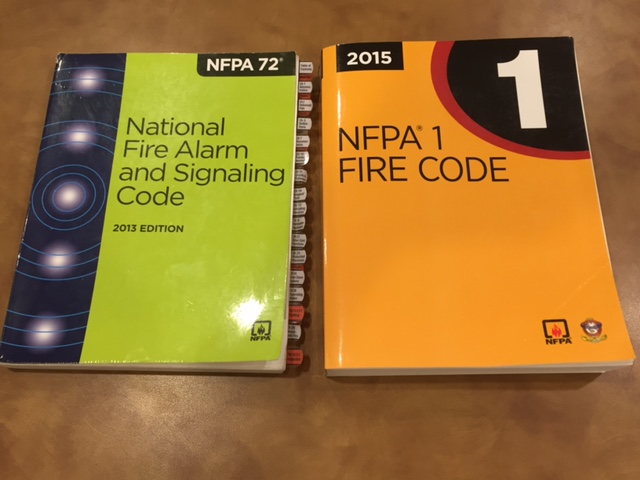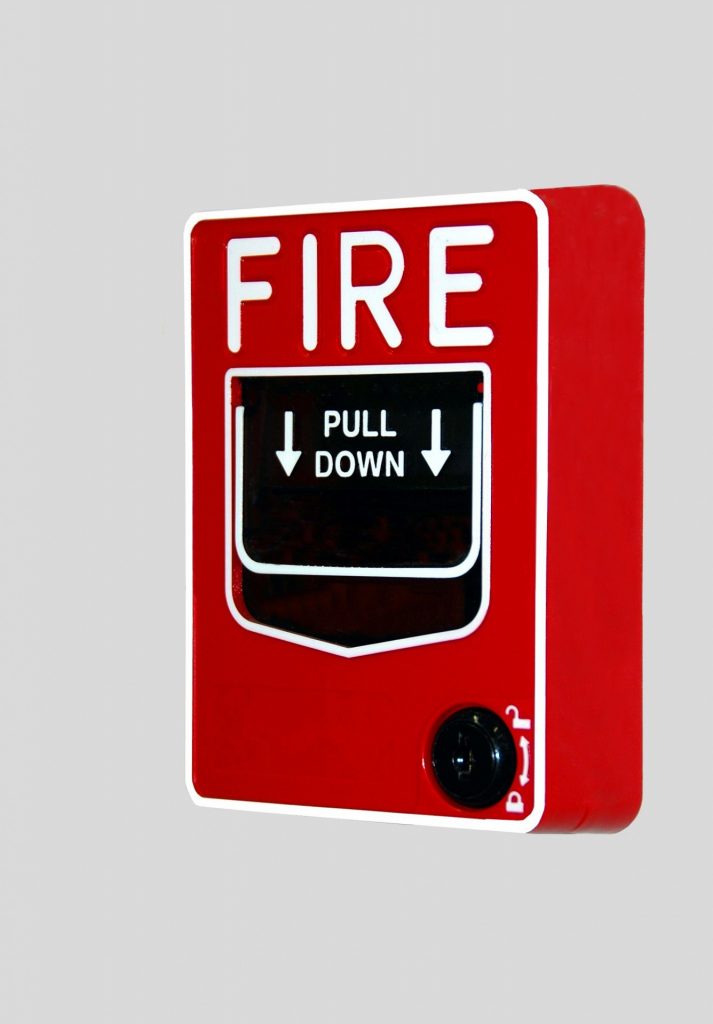Installing commercial fire alarms has long remained one of the most important facets of our company’s security offerings. These systems notify anyone in a business to a potential fire emergency. Moreover, they also create a fire department dispatch. This can save your business and, in some cases, even the lives of anyone in it during a fire! In this post, we share how we add this monitored commercial fire security, and explain the ins and outs of these important systems.
First, we’ll explain how we go about designing a complete commercial fire alarm. We must consult national fire codes to help us determine what types of fire alarm equipment to install, as well as where, in different types of commercial settings. Then, we’ll explain how we go about installing equipment that goes above and beyond the minimum detection required by fire code. Customers often ask for extra equipment to help secure particularly vulnerable or important areas of their businesses. Now, let’s dive in with a look at what it takes to design a fire alarm from the ground up!
How Do We Design a Commercial Fire System?
When it comes to securing any property, fire security sits right at the top of the priority list. Installing smoke, heat, and carbon monoxide detection with a central station response goes a long way towards minimizing the damage and danger of an emergency caused by these security threats. Unlike their residential counterparts, commerical fire systems are often installed because of legal requirements. State laws adopt national building codes that determine which types of businesses require the installation of monitored commercial fire security alarms.

The National Fire Protection Association Fire Alarm and Signaling and Fire Codes lay the foundation for laws that govern fire system installation and monitoring.
Specifically, the International Building Code (or “IBC”) uses several factors to make this determination. A building’s type of use and capacity greatly help determine if it needs a monitored fire alarm. Created by the International Code Council, or “ICC,” the International Building Code places businesses in certain “classes.” Examples of class types include retail spaces, places of worship, hotels and other boarding spaces, and schools. The IBC combines your type of business with factors such as building size and occupancy. Using these measures, the IBC shows you what type of fire system you require.
After determining fire system requirements, we design an alarm. In doing so, we use codes created by the National Fire Protection Association, or “NFPA.” Specifically, NFPA 72, the National Fire Alarm and Signaling Code, creates our guidelines for proper equipment placement and detector spacing. After we design our system, we submit our plans to the local building department for approval.
Installing Non-Required Fire Alarm Equipment
As you see, a lot can go into making sure businesses have the legally-required detection that they need. Moreover, many business owners also ask for additional equipment above and beyond the bare minumum required by law. For example, many customers look to add smoke detection in closets that house electronics or network devices. Additionally, basements and areas with water heaters or other major devices that can create carbon monoxide make great places to add monitored CO detection.
More often than not, we can install this non-required fire security wherever customers ask for it. However, we still must follow all legal guidelines regarding the installation of these devices. For example, we must install different devices at different heights to meet legal requirements. We must also use proper fire-rated wire, as well as proper wiring procedures, for installing all fire alarm devices. This goes for both required and non-required detection. Therefore, we treat installing requested devices with the same care and attention to detail as we take when installing devices required by law. At this point, you have a pretty good idea of the resources we use to help us design a fire alarm. Now, let’s turn our attention to the specific types of devices that comprise these alarms.
Commercial Fire Security Devices
When it comes to designing a fire alarm, we have an entire array of devices to install in every business we help secure. In this section, we explain these devices and their main “categories” of operation. More or less, main fire alarm equipment fits in one of just two equipment types. Let’s begin our conversation with a look at different types of “initiating” devices.
Initiating Devices
Initiating devices gain their name from the fact that they “initiate” an alarm by either detecting trouble or by allowing users to manually activate them to create an alarm response. For example, smoke detectors and heat detectors make up possibly the most popular initiating devices. We also install initiating devices that help monitor a customer’s other security measures. Sprinkler water flow sensors fit this description. These initiating devices create an alarm upon recognizing the activation of a building’s sprinkler system.
Finally, some initiating devices create alarm responses only when someone intentionally activates them. Namely, manual pull stations require action from individuals in order to create an alarm. Therefore, they do not have any fire or alarm trouble “detection” built into them at all. However, the fact that they create a fire alarm response still places them in the category of initiating devices. Now, let’s check out some devices designed to alert people to an alarm, rather than create one!

Manual pull stations are one of the most recognizable initiating devices on any fire alarm system.
Notification Devices
As you can probably guess by the name, notification devices notify those in the building about an alarm condition created by an initiating device. When people hear this, they often think of a siren as a potential notification device. However, fire alarms generally use devices called “horn strobes” that create both a blaring siren and blinking strobe response to alarm activation. We use horn strobes rather than sirens due to the Americans with Disabilities (or “ADA”) act of 1990. This act made it mandatory for businesses to include notification devices that alerted the hearing impaired to a potential emergency.
Additionally, we also install strobes that do not create sound at all to alert people to a fire. Installing a mix of horn strobes and their “lights only” counterpart helps ensure that people throughout a building have a visual cue to evacuate, without creating an unbearable amount of noise. Finally, speaker strobes create a vocal evacuation message to create an extra layer of notification to an emergency situation. These devices can even allow for the fire department or other emergency personnel to communicate directly through them with the use of a live paging microphone. As you can see, we use an impressive array of basic fire alarm components for both creating and communicating alarm events!
Putting it All Together
We hope that this post helps you see how we install monitored commercial fire security, and how it works. Additionally, we also encourage you to contact us with any questions this post may raise for you. We will happily answer any and all security-related inquiries you have at any time. Furthermore, we encourage you to take advantage of our free site survey program. We offer complimentary security audits and equipment quotes to both new and existing customers alike. While on site, we can address any security concerns you may have. Moreoever, we can also make suggestions of are own based on what we see during our visit.
Perhaps you have a business of your own that needs updated fire secuity. Or, maybe you wish to add on to your system with some non-required spot detection. Either way, we are here to help. We’ve worked with hundreds of customers in designing and installing fire alarm systems to create valuable monitored commercial fire security. Together, we can work with you to keep your business, and everyone in it, as safe and secure as possible!
